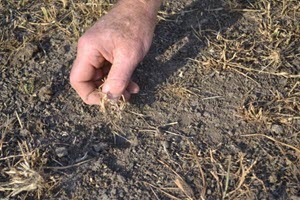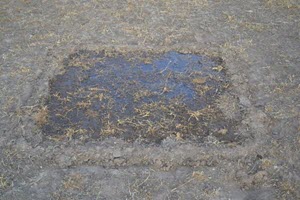To regrow or renew?
14 February 2019
Extreme temperatures and ongoing dry conditions across the majority of Australia's red meat production zone have pasture specialists recommending producers fully assess their feedbase ahead of autumn.
Consultant Cam Nicholson, who’s currently delivering the Feedbase Four (a series of projects in MLA's Feedbase Adoption Plan) said despite best management, minimal grazing and maintenance of surface dry matter, plants may have died.
"Most perennials survive long dry periods by stopping growth and going into survival mode. Their deep roots, which I call survival roots, access enough subsoil water to keep them alive. It’s why deep-rooted species such as phalaris and our native grasses survive better than, say, perennial ryegrass, which is shallow rooted," he said.
"Heat and stress will eventually kill these species too.
"Multiple stresses are deadly for plants and stress may also come from insects, low soil fertility and soil acidity as well as heat, lack of water and heavy utilisation. Grazing just adds another stress that will make things worse."
It's recommended producers group pastures into the following categories and plan ahead accordingly:
Category 1: Still lots of plants alive
ACTION: Business as usual and progress with feed budgeting, fertiliser planning and grazing management (see tips and tools to help below).
Category 2: Reduced number of plants remain
ACTION: Recovery plan to build up reserves after an autumn break. Develop a grazing and feeding plan for stock to reduce reliance on stressed pastures and manage weed control to reduce competition. Reduced numbers would be considered (per m²) five to 15 plants for phalaris, tall fescue and cocksfoot and eight to 30 plants for ryegrass.
Category 3: Plants virtually all dead
ACTION: Resow or oversow. Determine cash flow requirements, short-term feed needs, paddock preparation and weed control.
How to make the assessment
1. Pinch clumps of dry grass, twist and pull – see if they pull out. If they’re alive, the survival roots will keep them anchored.

Image: If the plant comes away from the ground easily, there’s a good chance it hasn’t survived.
2. Just add water. Apply two good waterings about a week apart. Twenty litres of water (a cleaned drench drum is ideal) spread over one m² (so one big step by one big step) is equivalent to 20mm rainfall. Create a small levy around the area with a shovel to hold the water in. Do this twice then observe about a week or so after the second watering for new shoots out of pasture clumps.
If soil is cracked and severely drought-affected, this method might not work and in heavy clays additional water might be required.

Image: Water a metre square of pasture to assess its potential to return under good seasonal conditions.
Tools for pasture assessment and recovery planning
- MLA's Tips and Tools for pastures which include: Looking After Drought Pastures, Managing Weeds After Drought, Improving Pasture Use with the MLA Pasture Ruler and Managing Soils to Keep them Healthy and Productive
- Making More From Sheep's pasture assessment module
- More Beef from Pastures
- The Queensland Government's AussieGRASS maps predict the chances of exceeding median pasture growth in three month periods for the entire country.
- MLA's sheep productivity webinar on identifying malperforming pastures.
- The EverGraze feed budgeting and tactical management guide
- MLA's Feed Demand Calculator and Rainfall to Pasture Growth Outlook Tool
More information:
Mick Taylor
MLA Project Manager – Feedbase
E: mtaylor@mla.com.au


